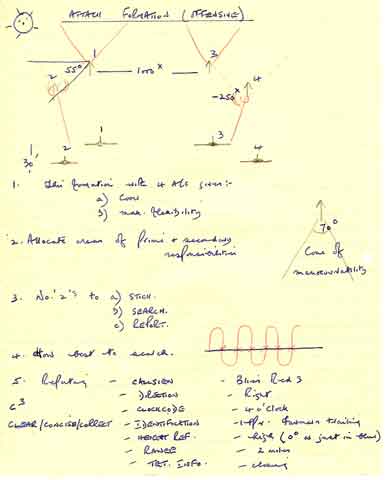|

The above briefing notes were written by Paddy Hine when a Flight Commander
on 93 Sqn and Brian Butterworth kept Paddy's handwritten notes.
This particular brief was obviously given on the DFCS course
as the base is West Raynham. Paddy is leading and the other members
of the formation are all well known fighter pilots of the time who were
either course students or DFCS staff.
ATTACK FORMATION (OFFENSIVE)
Comments in red
Diagram showing positions of the other aircraft relative to the Leader - No. 1. The deputy leader
is No.3. Nos.2 and 4 are usually junior members who fly on the wing of their section leaders.
1 and 3 are 1,000 yards apart line abreast and on the same level. Note the position of the sun.
No.3 looks into the sun. Nos. 2 and 4 fly 55° echelon back, 250 yards away and stepped down 30 feet.
The cones of search responsibility are marked by red lines - 1 and 3 looking forward, 3 and 4 looking
across the formation as far back as they can see. There is inevitably a "blind" cone immediately to
the rear of each aircraft. Where the "blind" cones of 2 and 4 intersect in the centre of the formation
is the closest an enemy can approach from the rear without either 2 or 4 being able to see him.
1. This formation with 4 a/c gives:-
a) Cover
b) Max. flexibility Diagram shows 70°cone of manoeuvrability which
refers to the area within which No.2/4's have
freedom to move during turns. When on steady
headings again, they would always ensure that
they were on he opposite side of the formation
to their colleague to maintain the essential
crosscover to the rear.
2. Allocate areas of primary and secondary
responsibilities.
3. No. '2's to a) STICK. These 3 words are driven into the brain of every junior No. 2.
b) SEARCH.
c) REPORT.
4. How best to search. Unless they have something to focus on, one's eyes naturally
relax and will focus on a point about 10 feet beyond your wingtip.
At altitude the sky is nearly black above the horizon and often
just a white cloud sheet or uniform haze beneath the horizon.
The best way to scan is as shown in the diagram, up and down
through the horizon. As your eyes pass through the horizon
make a conscious effort to re-focus at infinity on a cloud
structure or the horizon itself. If you do not you will be
unable to see an approaching aircraft. The other factor
working against you is that, by definition, an object on a
collision course with you, as an attacking aircraft would be,
is stationary against the sky - there is no relative movement
- making it even more difficult to pick up.
5 Reporting - CALLSIGN - Bliss Red 3
- DIRECTION - Right
C3 - CLOCKCODE - 4 o'clock
CLEAR/CONCISE/CORRECT - IDENTIFICATION - 1 Pr. Farmers trailing Farmer NATO code name
for Mig-19.
- HEIGHT REF. - high (0° as just in blue)
- RANGE - 2 miles
- TGT. INFO. - climbing
End of Page 3.
(Thanks to Chris Stone for being the Technical Advisor for this series.)
|







